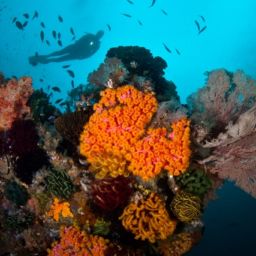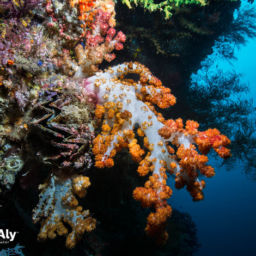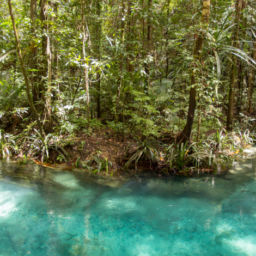Kneeling on the sandy bottom at Manta Sandy, in a shallow lagoon near Arborek Island in Raja Ampat, we wait patiently. The guides have promised us mantas. Lined up behind a row of coral rubble, we watch the coral bommies in front of us. It’s a manta-cleaning station, and we’re waiting for something to happen.
Wildlife experiences by their very nature can be unreliable, so I wonder, after about five minutes, if anything is going to happen. I play a mental game with myself, lowering my expectations. But suddenly, there’s commotion — the mantas are behind us. We fin across the sandy lagoon to the next patch of coral, where we can see several mantas gracefully looping the loop.
There are five, six, seven, and then eight mantas, moving in all directions. I take a few photos, shoot some video, and then just hang in the blue watching them.
Manta Sandy: an underwater ballet
These graceful creatures seem to be performing for us — an elegant manta ballet — as they loop around in circles and swim toward us in a perfectly straight, choreographed line. Then, they sweep around to start the movement again.
I notice they all have distinctive coloring. Some are completely black with a few white markings and some are white with a black-speckled underbelly. All of them, however, appear to be enjoying themselves as they perform this underwater ballet. They seem to smile at us with their big, gaping mouths as they pass by.
I’ve visiting a few manta sites before in Bali, Palau, Fiji and Lady Elliot Island on the Great Barrier Reef. Most of them involved battling either strong currents or cold water, or both. Manta Sandy is different. We hover in warm crystal-clear water, around 84 F (29 C), with no current at all. And it seems that you’re all but guaranteed a manta sighting.
Because this site is becoming so popular, the park rangers are sensibly limiting how many people can scuba dive (or free dive) here at once. Twenty divers get permits for each allotted time slot. Rangers guard the site during the day, issuing permits from a nearby jetty.
It’s a magical experience, which ends too soon (after around 60 minutes), when our dive guide leads us back to the boat. Back onboard, we look through each other’s photos and videos, counting eight mantas. That’s the most I think I’ve ever seen on a single dive.
Other highlights include nearby Arborek Jetty, famous schooling baitfish and, at night, a walking shark — the Raja Ampat epaulette shark. The colors and diversity at Melissa and Anita Reefs are breathtaking. Above water, we hike up a steep limestone peak at Pianemo to view the beautiful bay below and into the jungle to find the spectacular birds-of-paradise plants.
Deborah Dickson-Smith is one half of Diveplanit, a dive travel website she manages with her partner Simon Mallender, based in Australia.








